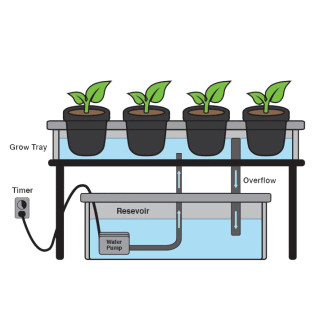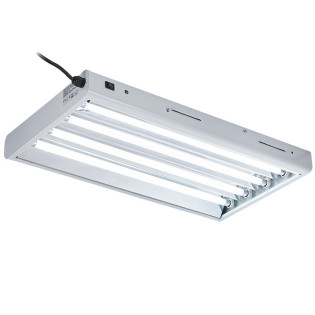
If you’re interested in learning how to grow hydroponic cabbage, one of your biggest hesitations might be wondering if this growing technique is all that it’s cracked up to be.
Is it really that easy to grow massive yields of cabbage plants - all indoors and without the use of soil?
Believe it or not, it is possible to engage in hydroponic cabbage growing - and its much easier than it might seem.
There are plenty of benefits to this style of growing when it comes to cabbage and other cold-weather crops - here’s what you need to know so that you can get started immediately.
Can Cabbage Be Grown Hydroponically?

Cabbage can be grown hydroponically, just as other brassica plants like kale and broccoli. It is versatile and easy to cultivate.
Not only that, but it has a variety of health benefits. There are many kinds of cabbage that can be grown hydroponically, and doing so will provide you with an ongoing fresh supply year round.
Is Hydroponic Cabbage Difficult To Grow?
Hydroponic cabbage is not difficult to grow, but since it’s raised for the head, you’ll need to use a hydroponic system that offers the cabbage plants plenty of room to grow.
We’ll walk you through choosing the right system later on - but for now, just know that hydroponic cabbage is not overly challenging to grow.
That’s especially true if you have some experience with hydroponics, particularly with other brassicas like Brussels sprouts or cauliflower.
If you do not have any experience in soilless cultivation, we recommend you check out our hydroponics 101 guide for a complete introduction.
Why Grow Hydroponic Cabbage?
There are several benefits to growing hydroponic cabbage. For one, as a cool-weather crop, hydroponic cabbage is easy and requires a very hands-off approach to gardening.

Rather than having to tend to your plants constantly, you’ll just need to monitor the nutrient solution and water, making sure the system doesn’t run out of either and changing it out as needed.
Hydroponics is one of the easiest systems you can use to grow cabbage. Not only can you achieve impressive yields in small spaces, but keeping pests & illnesses at bay is far easier indoors without the presence of soil.
Plus, cabbage is a squat, compact plant that requires no training, pruning, or supports - unlike plants like grapes. In general, the benefits of growing hydroponic cabbage include greater efficiency, faster & more plentiful harvests, and less work on your end!
How To Start Growing Cabbage Hydroponically
Now, you know that growing cabbage hydroponically is not just possible - but it's actually super advantageous! With that said, we're going to now explain how you can start your own crop - whether you're growing in a shed, a spare bedroom, or in a commercial greenhouse!
Of course, this starts with choosing the right system - so we'll start there. After that, we're going to cover fertilizer, propagation, harvest, and tips & tricks you need to know to successfully bring these plants from seed to harvest hydroponically.
What Type Of System Is Best For Growing Cabbage Hydroponically?
Ebb and flow is traditionally regarded as the best method of hydroponic growing for cabbage. This is one of the more popular systems for indoor growing in general, particularly for beginners. The biggest reason for this is because its so easy to maintain.
In ebb and flow, a water pump brings nutrients into a flood table, which is periodically flooded with water and nutrients before a timer drains it back out after a 10-15 minute soak.
Another option is a hydroponic drip system. These are unique in that they feed nutrients at the top rather than at the roots, relying on drippers without the need for aggressive flooding and draining.
These styles of hydroponic systems are sometimes referred to as hydroponic irrigation systems. They’re great for larger operations but can be used for small-scale growers, too.
Not sure which one is right for you? Our list of the best hydroponic systems of the year is a good place to start. But rest assured that no matter which system you opt for, you can find it for the best prices online here at Hydrobuilder - and with the best service online.
Hydroponic Cabbage Propagation - Seeds vs Clones
The best way to propagate cabbage for hydroponic growing is by germinating seeds. A cool-season crop, cabbage is best planted in the early spring or mid to late summer (if you want a fall or winter harvest).
It grows best in temperatures around 65 to 75 degrees but can tolerate temperatures as low as 25 degrees. Curious about the best varieties to grow?
There are all kinds of options to choose from. Some popular varieties include Dynamo, which is resistant to both disease and splitting, along with Fargo, which is a green cabbage that matures quickly.
Primax is another split-resistant cultivar, while Red Express is a fast-maturing variety. Categories of cabbage to grow in your hydroponic system include:
- Savoy
- Ballhead
- Red, white, purple, green
- Loose-leaf
Sow your seeds in the early spring, starting them off a bit warmer than they would be as mature crops (about 65 degrees is ideal).
Scarify the seeds before planting, which will encourage a better germination rate. Plant in starter plugs or coco.
After they’re planted, these seeds should germinate in less than a week. You can transfer the seedlings into the hydroponics system when they are at least four inches tall and have two to four sets of true leaves.
When you transplant, don’t crowd the plants together. This can make the system harder to care for and will increase the likelihood of fungal diseases. Keep at least 18 inches between each seedling.
Feeding Your Hydroponic Cabbage Nutrients
Cabbage plants are heavy feeders but fortunately, there are lots of hydroponic nutrient solutions designed specifically for cabbage and similar brassica plants.
These can easily be purchased online here at Hydrobuilder. These contain a nutrient balance that will help your cabbage plants thrive, and make it easy to feed everything they need.
Most cultivars require a pH of around 6.2 to 6.6 and an EC of 2.5 to 3.0. Being a heavy feeder, cabbage will likely use up your nutrient solution faster than other plants, like hydroponic tomatoes.
Therefore, you’ll want to keep a close eye on the nutrient levels in your system. You may have to replace nutrients every few days, and constantly monitor concentration with an EC meter and pH with a pH pen.
Caring For Your Hydroponic Cabbage
Caring for your hydroponically grown cabbage is relatively easy once you've got your system dialed and your seeds sprouted. From there, it's just a matter of ensuring they have ample grow lighting and dialing in the grow room climate.
Cabbage plants should be kept under either LED or fluorescent grow lights. They only need about six hours of light per day, since they are cold-weather crops.
When your plants begin to mature, don’t feel the need to keep them in bright light. On The contrary, cabbage does best with a little bit of shade so that it doesn’t bolt or crack.
Cabbage is very prone to drought stress, so make sure that plants don’t run out of their nutrient-rich water solution. If they get too dry, the head will crack and serve as an open invitation for diseases and pests to plague your plants.
You’ll need to be especially vigilant for cracking as your cabbage plants mature. As the cabbage becomes heavier and denser, the heads can burst - unless you’re able to stop the growth in time.
Inadequate humidity can alter the internal water pressure so it’s important that you maintain consistent watering and fertilizing during the entire life of your cabbage plants. If necessary, you'll need to bring a grow room humidifier into the grow room to add that moisture in yourself.
Cracking can also be avoided by keeping temperatures low, under 80 degrees to be specific. Excess heat also cause them to go to seed prematurely. This process, known as bolting, can be prevented by providing plenty of water and relatively low temperatures.
Watch out for pests like aphids, cabbage worms, and loopers. These are not as common in indoor hydroponic environments, but should they threaten the health of your plants, you may wish to use an insecticide.
How To Harvest Your Hydroponic Cabbage Production
Cabbage can be harvested around 65 to 100 days after planting. This, of course, depends on the type of cabbage you are growing and what size head you would like to harvest.
You’ll know your plants are ready to be harvested when the heads are firm and tight. Many cultivars can be harvested by the leaf, too, allowing you to enjoy a cut-and-come-again kind of harvest.
Final Thoughts On Hydroponic Cabbage
Ready to get started with growing cabbage hydroponically? Hydroponic cabbage is not only just as healthy for you as the traditional kind, grown right in the soil, but it is also remarkably easy to grow.
With a bit of practice and the right knowledge, you’ll have no trouble at all growing massive yields of cabbage for your whole family to enjoy.
You can find everything you need to start your hydroponic cabbage garden today by shopping Hydrobuilder’s extensive hydroponic growing collection.




































